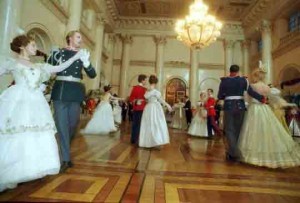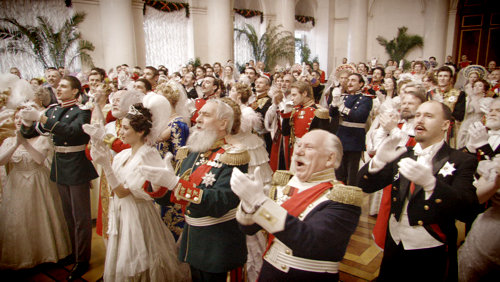Building the world in which an alternate reality game or transmedia experience can play out successfully is like planning and directing a single-shot film.
 In 2001, Alexander Sokurov set out to film a unique drama called Russian Ark – a film shot entirely with one take at the Hermitage Museum in St. Petersburg. Comprised of over 2000 actors plus the cast and crew, it took three attempts to film the entire script successfully. Imagine the ordeal with those first two failed attempts, having to rewind completely and start from scratch because of a single unrecoverable mis-step somewhere in the filming process. Yet nonetheless, having every cue and movement planned and practiced, Sokurov and his cinematographer Tilman Büttner managed to capture their story to their satisfaction in one day, in a single long take.
In 2001, Alexander Sokurov set out to film a unique drama called Russian Ark – a film shot entirely with one take at the Hermitage Museum in St. Petersburg. Comprised of over 2000 actors plus the cast and crew, it took three attempts to film the entire script successfully. Imagine the ordeal with those first two failed attempts, having to rewind completely and start from scratch because of a single unrecoverable mis-step somewhere in the filming process. Yet nonetheless, having every cue and movement planned and practiced, Sokurov and his cinematographer Tilman Büttner managed to capture their story to their satisfaction in one day, in a single long take.
For a production like that to be successful, the actors and crew need to know what’s coming and when so that they can produce what the director is looking for without straying so much as to break the intended flow of the production. They are within the environment and immersed in their roles and tasks, prepared for the camera and their cue. If something doesn’t go precisely as planned when the shot comes, they should be flexible in their actions, prepared to improvise, even having potential contingencies so as to keep the story flowing and natural enough that the director doesn’t have to scrap the entire take and start over. The director especially needs to be ready to improvise instructions at a moment’s notice to avoid a dreaded, unavoidable “Cut!”.
In forming a storyworld in which an ARG takes place, the environment should be built so it is, in theory, a living and thriving place on its own. Ideally, there should be room for discovery and contingency, prepared back-stories and fleshed out characters (whether ultimately discovered by players or not), websites, tools, and technologies at the ready. Flexibility is necessary for interactivity, at those times where the audience can have an effect on their surroundings, on characters and events, or even when they curiously wander off the path to explore. The response from the created world should be natural and smooth so as to keep the story flowing and believable, even if it directs them back on the path. Then a dynamic and flexible story can be told within it, minimizing mis-steps and taking the audience and players along for the experience that was intended.
In a successful ARG, there is no premature “Cut!”, there should be no immersion-breaking interruption from the director, or puppet-master. There is only a starting point and intended goal, with each essential beat in between defined to whatever degree of flexibility is desired to produce the desired experience, and remain as natural and complete as possible – all in one long shot.

If the PM yells “Cut!”, or steps in front of the camera while not themselves being a part of the storyworld, it can remove the player from their immersion and destroy the intended storytelling experience. The players may also interact with the world in an unexpected way. If the PM panics, uncertain of how to respond, and that may cause confusion and derail actors or crew, breaking the feasibility of the world and removing the player from the immersion.
Here, there can be no unplanned cut or edit, no re-take or removal of unwanted mistakes.
Roger Ebert, in reviewing Russian Ark, commented:
If cinema is sometimes dreamlike, then every edit is an awakening. “Russian Ark” spins a daydream made of centuries.
An ARG is an experience that is, by definition, an “alternate reality” – a dream-like progression through a fictional story taking place in our personal world. We should be able to interact with it, explore it, learn from it; it may even affect us in such a way as to open our eyes to new ways of thinking in our real world. Like any good dream (even nightmares!), waking up unexpectedly from it can leave us with a sense of incompletion, a wondering of what would have happened next, perhaps even frustration at being unable to complete our “dream’s” story.
Puppet-mastering an ARG or an interactive transmedia experience is like being a director for a single-shot film — but without the ability to start over. You must be prepared, be flexible. Build the world in which the story takes place, including its cues and essential content – first. Pay attention! Try not to trip up the camera operator once filming’s begun, and try to hire competent actors and crew who can improvise yet still fill the roles they’re placed in enough that nothing irreparably breaks.
And finally, unless you’re also an actor, stay behind the camera!


